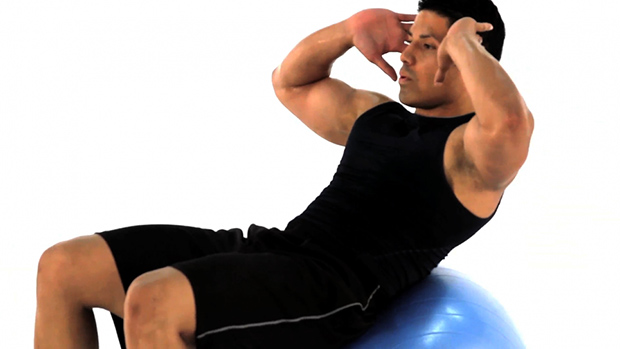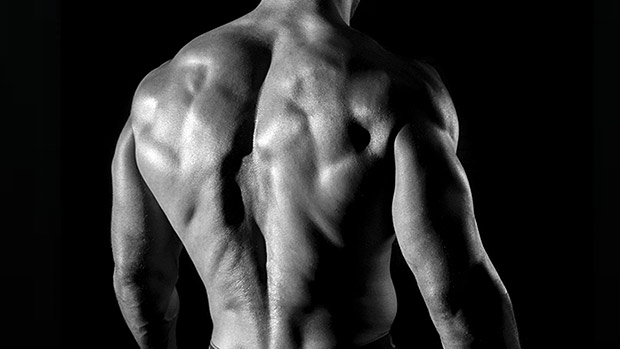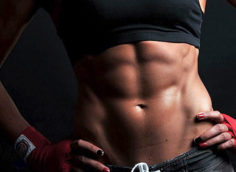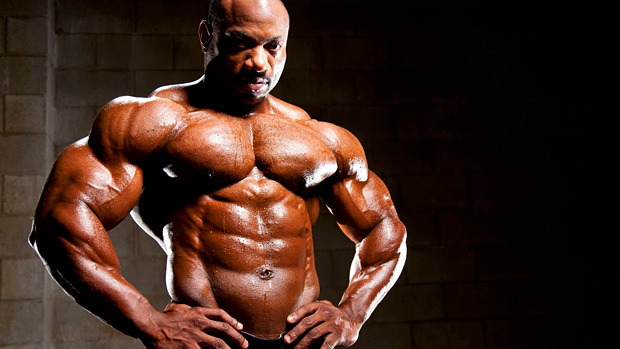Some time ago, I saw a news report about a guy who'd set some kind of world record for sit-ups. I'll admit he was impressive; he could do thousands. And yet, the guy had no visible abdominal development. Not even a cosmetic outline.
If the purpose of sit-ups is to train abdominal muscles, why wouldn't the world-record holder have some signs of ab development? The answer is simple: He'd trained his body to perform an exercise. He wasn't training his muscles at all.
Traditional ab training is based on the idea that the muscles function by bringing your pelvis closer to your rib cage. According to that simplistic view of biomechanics, any movements that accomplish this, like sit-ups and leg raises and all their variations, also accomplish your goal of training your abs.
But, as I said, they don't.
They also fail to give you all the other things you're looking for when you work your abs: a narrow waist, a pain-free lower back, and a stronger body in general.
How to accomplish all that, if traditional ab training doesn't do the trick? Sports offer a clue.
Athletic Supporters
I'll say this up front: You can't look at someone with an exceptional body or body part and assume that you can achieve the same results by mimicking his workouts. Setting aside the issue of genetics – you can't train a powerlifter to look like a runner, just as you can't train a runner to look like a powerlifter – there's far too much individual variation in the way we respond to the workouts we do.
We can, though, look at systems of training and draw some conclusions about adaptive responses.
Let's start with gymnasts and acrobats. To the best of my knowledge, few of them do any formal abdominal training, yet any one of them has abs bodybuilders should envy – all the muscular development without blocky obliques or a bulging rectus abdominis. I don't think it's a coincidence that they also have perfect glute development.
Of course elite gymnasts and acrobats are genetically predisposed to be good at those activities. The ones you see in the Olympics or at Cirque du Soleil are selected early in life and train hard for hours a day.
But that doesn't mean we can't learn important lessons from their training systems, particularly when we contrast them with the traditional approach to ab exercise. Specifically, they use their mid-body muscles for three purposes, all of which are related to the overall goal of strength transfer.
- Coordination: I don't think I need to explain why this is important to an athlete.
- Range of motion: This works both ways – you can hurt yourself with too little or too much range of motion.
- Muscle contraction: Different types of muscle contractions help you stabilize your body, create force, resist force, overcome force, accelerate, and decelerate. In bodybuilding we tend to focus on producing force, but in sports it's just as important to be able to reduce force, or at least transfer that force. No matter what sport we're talking about, we assume that we generate power from the ground, but we express it through the muscles in the middle of the body.
Core Competency
The phrase "core training" gets used often enough these days, but there's no one definition of what that means. Some experts assert that "all training is core training." While partially true, it's also misleading. At the other extreme, bodybuilders tend to think of abs as a separate entity, a "body part," which is equally misguided.
I like to talk about "the core" as a box, with the abs in front, the paraspinals and glutes in the rear, the diaphragm on top, and the hip girdle and pelvic floor on the bottom. Within the box are 29 pairs of muscles that help stabilize the spine, pelvis, and movement chain during every type of movement.
One key to understanding how the core works is to resist thinking of muscle actions in terms of straight lines. Most movement patterns are diagonal or rotational. That's why muscles, joints, and bones are connected in diagonal and spiral patterns.
I agree with Vern Gambetta when he says this: "Athletes who move in many directions, and have to control their limbs in a variety of positions, have ripped abdominals as a result of movements they perform, as opposed to isolated work."
So how do we adapt that into a training program? Bodybuilders aren't gymnasts, so we have to forget about exercises that demand profound coordination or talent. There'd be too long a learning curve. We can get there faster by creating two types of exercises that challenge you without forcing you to enroll in circus camp:
- Static exercises, in which you have to control your limbs in space in a variety of movement planes and ranges of motion. An example would be a plank exercise in which you raise one leg and hold it out to the side.
- Movement-based exercises, which force muscles to work together in multiple planes of motion and with various degrees of rotation. An example would be standing wood chop-type exercises using a medicine ball. You can chop in vertical or horizontal patterns, or any diagonal pattern in between.
A Quick Word about Hip Flexors
I've left open the question of why sit-ups and crunches aren't good exercises for abdominal muscles. After all, even if they aren't the best exercises, they still do the trick, right? Not really. The problem comes from what we call the "psoas paradox." The psoas major is a hip-flexor muscle, meaning it acts to pull your thigh bone up toward your torso. In conjunction with two other hip flexors – the iliacus and the rectus femoris (part of the quadriceps group) – it can take on most of the work in traditional ab exercises. This was likely the case with our world-record holder in sit-ups, who showed little to no abs development.
A study published in 1965 showed that most people use two of those muscles, the rectus femoris and iliacus, to initiate a sit-up. A study published in 1994 showed that the psoas and iliacus are most involved in the exercise after about 30 degrees of hip flexion. Between those two points, there's not a lot of room for the abdominals to take over as prime movers.
That's why we have the crunch. By shortening the range of motion of the traditional sit-up, it takes much of the hip-flexor involvement out of the movement. But that's all you're doing with the crunch. You aren't burning many calories, and there's hardly any functional benefit to working muscles through such a such range.
Standing Movements
The key to all these movements is speed. You want to emphasize acceleration and deceleration. Don't fall back on the controlled tempo that's used in most bodybuilding programs. Movement training is not isolation training.
You also want to make sure you progress – don't do the same version of the same exercise the same way in workout after workout. Progression on these exercises follows a hierarchy. Work on these variables, in this order:
- Speed of Movement
- Range of Motion
- Load
In other words, first work to increase your speed. Then work to extend your range of motion, where appropriate. Finally, use heavier weights.
On all these standing exercises, 10 to 15 reps per set is a good target.
Choppers
Hold a medicine ball or dumbbell with both hands. Spread your feet about shoulder-width apart. Push your hips back, as if you were preparing to jump, and start the movement with the ball or dumbbell between your legs and as far back as you can reach. Now pull it upward as fast as you can until your arms are fully extended overhead. Immediately squat down for the next rep.
You can do any number of variations. Change the angles by going from vertical to horizontal or diagonal. With cables or tubing, you can go high to low or low to high.
When you're doing diagonal chops – low to high or high to low – you can pivot on one foot to extend your range of motion. That involves both the front and rear oblique systems. The best benefit of doing choppers with a pivot is the simultaneous inclusion of both the anterior and posterior oblique systems.
Standing Straight-Arm Crunches with ABC option
You can use a high cable or tubing. Stand with your feet shoulder-width apart and grab the handle or end of the tubing with both hands. With your arms straight, pull straight down to the floor, between your legs.
As I said earlier, start by emphasizing speed, then work on your range of motion, then on increasing the load.
To increase range of motion and work through multiple movement planes, use the ABC option: Pull straight down between your legs on the first rep. Then on the next rep go to the outside of your left foot. On the third rep pull to the outside of your right foot. Then repeat the cycle.
Duck-Unders
This is generally considered a "mobility" exercise, but I like it as a core exercise, engaging many mid-body muscle groups during lateral movements.
Set up a barbell in a squat rack at about hip-height. While standing on one side of the bar and sideways to it, take a long lateral lunge as you duck under the bar. Bring your trailing leg through and stand up on the other side of the bar. Now lunge with the other leg and duck back under, standing up in your original position. That's one rep. Keep moving until you've finished all your reps.
Start your next set standing on the opposite side of the bar. So if you started off with a lateral lunge with your left leg on the first set, you'll start with your right leg on the second set. (You can see a slight variation in this article by Eric Cressey.)
Push-up Variations
Static holds from the push-up position have a pronounced effect on the muscles of your core. These are just a few of the variations you can try – hold each one for a slow count of 30:
- Hands on floor, toes on Swiss ball.
- Hands on different-size medicine balls, feet on Swiss ball.
- Hands on one medicine ball, feet on Swiss ball.
- Three-point push-up hold, with one arm or leg in the air.
- Three-point push-up hold, one leg in the air, doing movements (such as circles) with the free leg.
T-Push-ups
Grab a pair of light hex dumbbells and get into push-up position, with your hands directly beneath your shoulders, holding the dumbbells so they're parallel to your body. Do a push-up, and as you come up, rotate your upper body to the right and extend your right arm until it's at 90 degrees to your torso and perpendicular to the floor. Come back down, do another push-up, and this time rotate to the left, lifting your lift arm. Do eight to 12 reps to each side.
Dumbbell Pull-ins
Grab a pair of heavy dumbbells and get into the push-up position, as described for the previous exercise. Pull one dumbbell up to the side of your waist, slowly lower it to the floor, then repeat with the other arm. You'll feel it in your lower abs, as well as your glutes. You can use a range of sets and reps, depending on the amount of weight you use.
Swiss-Ball Alternating Step-offs
This is one of my favourites. Start in a locked-out push-up position with your toes on top of a Swiss ball. Slowly take one leg off the ball and, keeping it straight, lower it as far out to the side as you can. Touch the floor with the toe, then slowly raise it back up to the ball and repeat with your other leg. It forces your lower abs and glutes to function as a unit to control, stabilize, and move your body in a challenging position.
Three-Point Push-ups with Staggered Hands
Get into push-up position, but this time stagger your hand spacing – one hand farther out in front than the other. Now raise one leg and extend it as far to the side as you can, keeping it straight. Do as many slow push ups as you can. It creates incredible stability demands throughout the core.
Contralateral Hand-to-Toe Touch
Once again, start off in push-up position. Now bring your right leg under your body and touch your toes with your left hand. Repeat to the other side, and do as many reps as you can. This move is a monster. With its extreme demands for both rotation and stabilizing strength, it creates incredible intra-abdominal force as it engages the transverse abdominis. The higher you can get your leg, the more intense will be the demand.
To make it easier, simply decrease the range of motion.
The Flip Side
This brings me back to the gymnasts I mentioned at the beginning. The exercises I included here impose demands on your core muscles similar to the challenges faced by gymnasts as they go through their routines. Their abs are quilted – never large, blocky, or distended. And they get that look without special diets or hours of cardio.
Contrast that with today's bodybuilders. Lately I've heard that some are trying to offset their distended midsections by not doing any abdominal work at all.
That's some truly faulty logic. Never underestimate what core training can do for you. If you don't believe me, you need to spend a little more time watching world-class gymnasts and acrobats in action.





